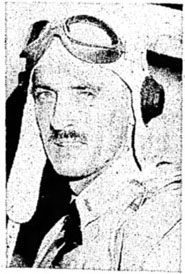Local Flyer Holds Record for Flying Torpedo Planes
Lt. Smith Is Now Operating From Carrier Off Philippine Islands
Editors Note: The following story about Lt. Stephen Smith, whose wife and 3 children live at 115 116th S.E., was carried in the air section of the army and navy department of the Jan 8. issue of 'Time." This is not the first honorable mention of the Mason City lieutenant who is distinguished as having "flown torpedo bombers more hours than any other living man."
He was also named in the book, "Then There Was One," which gives a graphic description of the many exploits of the Aircraft Carrier Enterprise, one of them tells of the local navy officers repairing the steering gear of his ship, while working in a temperature of 180 degrees. He is the son-in-law of Guy Davis, 6363 East State.
Not all flyers are tall, husky, glamour boys. Lt. Stephen Smith, U.S.N., is a slight 42 year older with a heavy mustache. He has a wife, a 14 year old daughter, 2 small sons. "Smitty" also has a record which will be hard to beat.
Smitty, who learned to fly about the time a lot of the World war II pilots were learning to walk, has flown more than 6,200 hours. In 169 landings on carriers, he has brought his plane in without ever flattening a tire. Worst wear and tear on any of his planes has come from enemy gunfire which was not accidental.
Smitty has been bombing Japs since the beginning of the war and has flown torpedo bombers more hours than any other living man in the navy. Last week he was still at it, flying off the Essex-class carrier near the Philippines. Like Ty Cobb in his later years, Smitty now automatically sets a record every time he goes to bat.
Stephen Burdette Smith had to lie about his age to get into the navy back in 1919. He was just 16 when he went off to boot camp at Great Lakes. In 1927, at aviation school, he took his first uncertain solo hop. Fifteen years later Chief Machinist's Mate Smith flew off the Enterprise against Jap-held Kwajalein, and on June 3, 1942, worrying about a photograph he had meant to send to his wife, Smitty in an old TBD chugged into the Battle of Midway.
"We went in 50 feet off the water without fighter cover," he remembers. "The Japs were firing into the water ahead of us and firing antiaircraft bursts to direct their fighters to us. A Zero riddled my radio and my armor plate and my radio-man's armor plate, then shot up one of my gas tanks. I didn't think we had a chance so I went on in and got up close to the Jap carrier before I let the torpedo go. I think I got a hit. Mostly I was saying "Mom, I'm afraid you'll never get that picture."
Out of 40 outmoded TBDs which had taken off from U.S.carriers that day, only 4 came back. Smitty's battered bomber was one of them. Mom got her picture. Smitty got 1, a commission as ensign: 2, a navy cross and a citation which reads in part: "His extreme disregard of personal safety contributed materially to our success of our forces."
When Smitty, aged 41, became a lieutenant, he set another kind of record. With his "fogies" (extra pay for years of service) allowances and flying pay, he was earning $730 a month, became probably the navy's best-paid lieutenant.
Source: The Mason City Globe-Gazette, January 6, 1945 (photo included)
![]()

"DURABLE" SMITH IN TORPEDO PLANE - Lt. Stephen B. Smith of 115 16th S.E., Mason City, is flying a torpedo plane from one of the navy Essex-class aircraft carriers in the Pacific.
Known as "Durable" Smith to his squadron mates, the 42 year old pilot probably is the navy's oldest combat flyer. He enlisted as an apprentice seaman in 1919 at the age of 16 and worked his way up through the ranks.
Lt. Smith, who has been decorated with the navy cross, is credited with more flying hours in torpedo planes than any other pilot in the navy.
Source: The Mason City Globe-Gazette, February 22, 1945 (photo included)
![]()
Stephen Burnette Smith was born May 12, 1903 to Oscar D. and Daisy Fox Smith. He died Nov. 10, 1970 and is buried in Rockwell Cemetery, Rockwell, IA.
Source: ancestry.com
![]()

